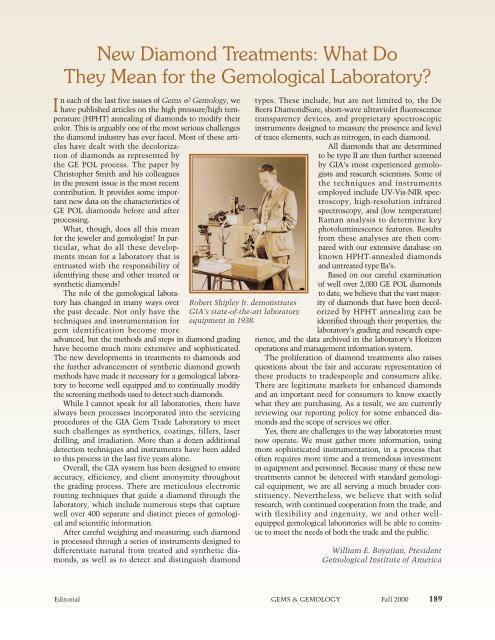Fall 2000 Gems & Gemology - Gemfrance
Fall 2000 Gems & Gemology - Gemfrance
Fall 2000 Gems & Gemology - Gemfrance
Create successful ePaper yourself
Turn your PDF publications into a flip-book with our unique Google optimized e-Paper software.
I<br />
New Diamond Treatments: What Do<br />
They Mean for the Gemological Laboratory?<br />
n each of the last five issues of <strong>Gems</strong> & <strong>Gemology</strong>, we<br />
have published articles on the high pressure/high temperature<br />
(HPHT) annealing of diamonds to modify their<br />
color. This is arguably one of the most serious challenges<br />
the diamond industry has ever faced. Most of these articles<br />
have dealt with the decolorization<br />
of diamonds as represented by<br />
the GE POL process. The paper by<br />
Christopher Smith and his colleagues<br />
in the present issue is the most recent<br />
contribution. It provides some important<br />
new data on the characteristics of<br />
GE POL diamonds before and after<br />
processing.<br />
What, though, does all this mean<br />
for the jeweler and gemologist? In particular,<br />
what do all these developments<br />
mean for a laboratory that is<br />
entrusted with the responsibility of<br />
identifying these and other treated or<br />
synthetic diamonds?<br />
The role of the gemological laboratory<br />
has changed in many ways over Robert Shipley Jr. demonstrates<br />
the past decade. Not only have the GIA’s state-of-the-art laboratory<br />
techniques and instrumentation for equipment in 1938.<br />
gem identification become more<br />
advanced, but the methods and steps in diamond grading<br />
have become much more extensive and sophisticated.<br />
The new developments in treatments to diamonds and<br />
the further advancement of synthetic diamond growth<br />
methods have made it necessary for a gemological laboratory<br />
to become well equipped and to continually modify<br />
the screening methods used to detect such diamonds.<br />
While I cannot speak for all laboratories, there have<br />
always been processes incorporated into the servicing<br />
procedures of the GIA Gem Trade Laboratory to meet<br />
such challenges as synthetics, coatings, fillers, laser<br />
drilling, and irradiation. More than a dozen additional<br />
detection techniques and instruments have been added<br />
to this process in the last five years alone.<br />
Overall, the GIA system has been designed to ensure<br />
accuracy, efficiency, and client anonymity throughout<br />
the grading process. There are meticulous electronic<br />
routing techniques that guide a diamond through the<br />
laboratory, which include numerous steps that capture<br />
well over 400 separate and distinct pieces of gemological<br />
and scientific information.<br />
After careful weighing and measuring, each diamond<br />
is processed through a series of instruments designed to<br />
differentiate natural from treated and synthetic diamonds,<br />
as well as to detect and distinguish diamond<br />
types. These include, but are not limited to, the De<br />
Beers DiamondSure, short-wave ultraviolet fluorescence<br />
transparency devices, and proprietary spectroscopic<br />
instruments designed to measure the presence and level<br />
of trace elements, such as nitrogen, in each diamond.<br />
All diamonds that are determined<br />
to be type II are then further screened<br />
by GIA’s most experienced gemologists<br />
and research scientists. Some of<br />
the techniques and instruments<br />
employed include UV-Vis-NIR spectroscopy,<br />
high-resolution infrared<br />
spectroscopy, and (low temperature)<br />
Raman analysis to determine key<br />
photoluminescence features. Results<br />
from these analyses are then compared<br />
with our extensive database on<br />
known HPHT-annealed diamonds<br />
and untreated type IIa’s.<br />
Based on our careful examination<br />
of well over 2,000 GE POL diamonds<br />
to date, we believe that the vast majority<br />
of diamonds that have been decolorized<br />
by HPHT annealing can be<br />
identified through their properties, the<br />
laboratory’s grading and research experience,<br />
and the data archived in the laboratory’s Horizon<br />
operations and management information system.<br />
The proliferation of diamond treatments also raises<br />
questions about the fair and accurate representation of<br />
these products to tradespeople and consumers alike.<br />
There are legitimate markets for enhanced diamonds<br />
and an important need for consumers to know exactly<br />
what they are purchasing. As a result, we are currently<br />
reviewing our reporting policy for some enhanced diamonds<br />
and the scope of services we offer.<br />
Yes, there are challenges to the way laboratories must<br />
now operate. We must gather more information, using<br />
more sophisticated instrumentation, in a process that<br />
often requires more time and a tremendous investment<br />
in equipment and personnel. Because many of these new<br />
treatments cannot be detected with standard gemological<br />
equipment, we are all serving a much broader constituency.<br />
Nevertheless, we believe that with solid<br />
research, with continued cooperation from the trade, and<br />
with flexibility and ingenuity, we and other wellequipped<br />
gemological laboratories will be able to continue<br />
to meet the needs of both the trade and the public.<br />
William E. Boyajian, President<br />
Gemological Institute of America<br />
Editorial GEMS & GEMOLOGY <strong>Fall</strong> <strong>2000</strong> 189


